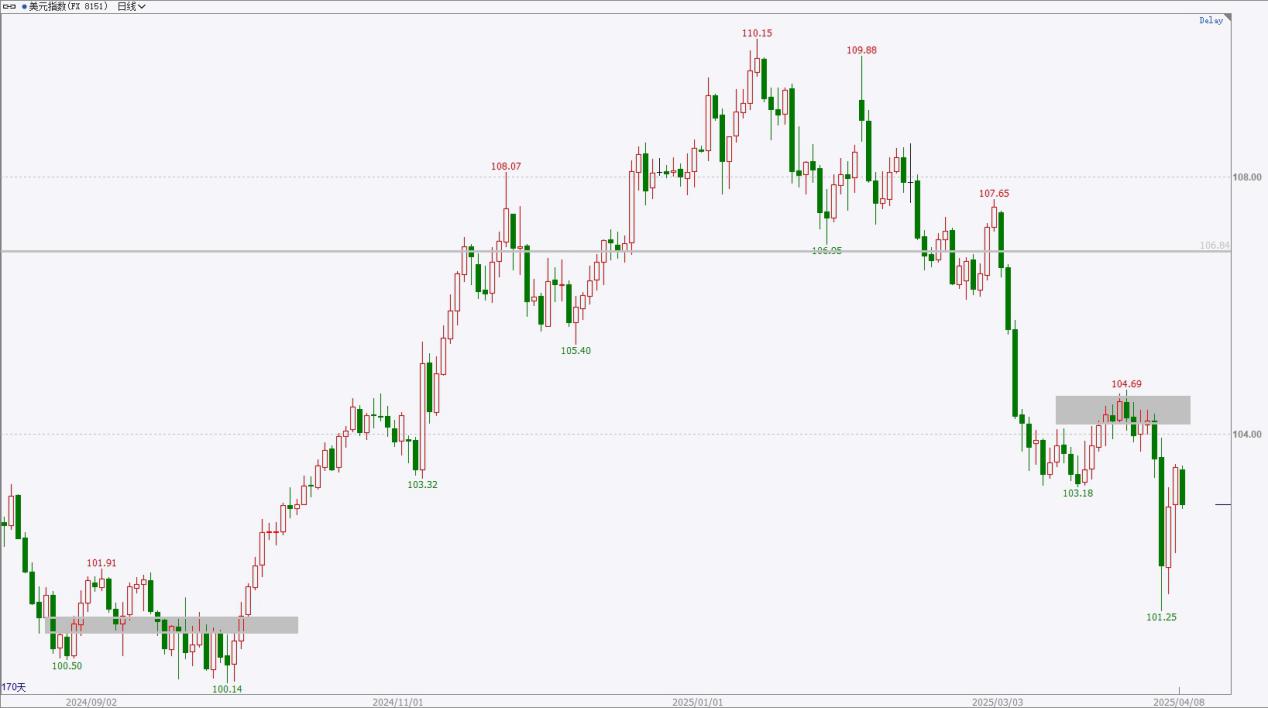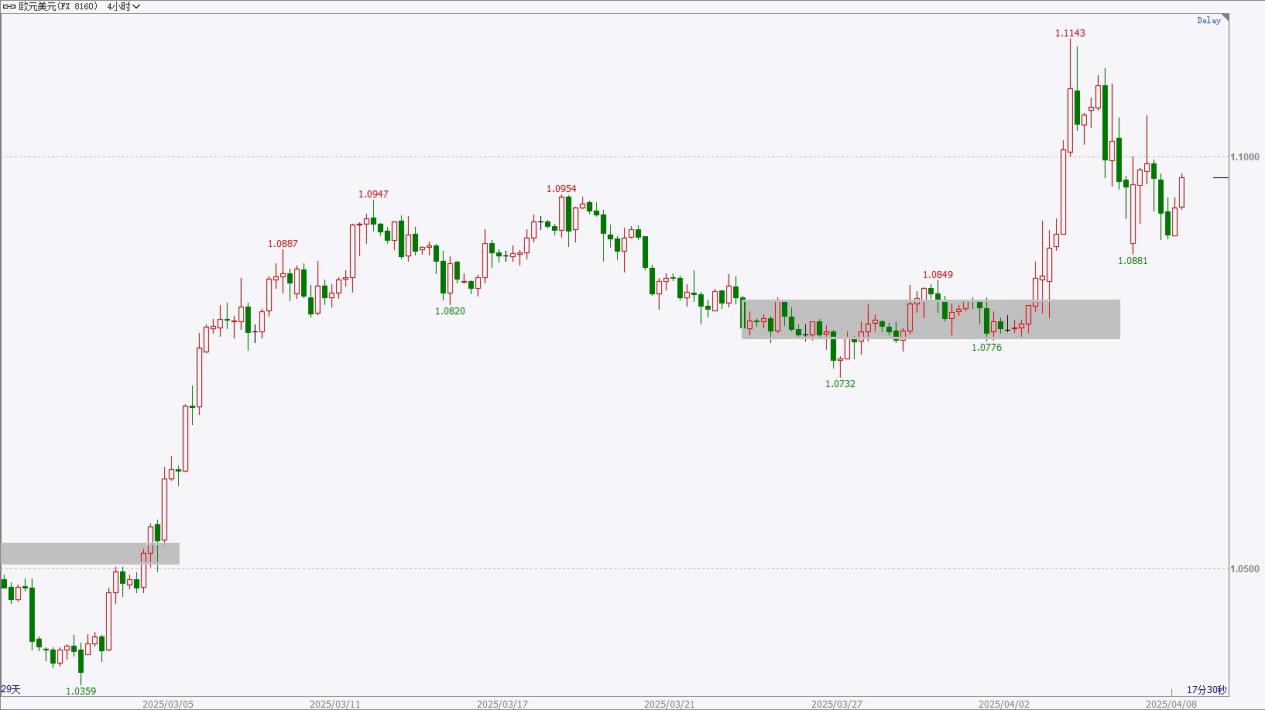|
Time
|
Data and Events
|
Importance
|
|
07:50
|
Japan’s February Trade Balance
|
★★★
|
|
14:45
|
France’s February Trade Balance
|
★★★
|
|
18:00
|
U.S. March NFIB Small Business Confidence Index
|
★★★
|
|
Following Day
00:00
|
EIA Releases Monthly Short-Term Energy Outlook Report
|
★★★
|
| |
|
|
|
Variety
|
Perspective
|
Support Range
|
Resistance Range
|
|
U.S. Dollar Index
|
Weak Volatility
|
100-101
|
104-104.5
|
|
Gold
|
Weak Volatility
|
2900-2920
|
3020-3050
|
|
Crude Oil
|
Weak Volatility
|
56-57
|
62-63
|
|
Euro
|
Strong Volatility
|
1.0750-1.0800
|
1.0950-1.1000
|
*Pre-market insights are time-sensitive and limited in scope, are predictive only, and are for reference and learning; they do not constitute investment advice, and operational risks are to be borne by the individual. Investment carries risks; trading requires caution.
Fundamental Analysis:
In the March meeting, the Federal Reserve maintained interest rates, the labor market remained steady, raised inflation expectations for the next two years, and lowered GDP growth expectations for the next three years. Starting in April, the pace of balance sheet reduction will slow, and tariff policies present uncertainties. March non-farm data showed an increase of 228,000 jobs, significantly exceeding expectations, while the unemployment rate slightly rose, indicating a strong labor market. The February seasonally adjusted CPI year-on-year was slightly lower than the previous value and expectations; February core PCE price index showed a slight rebound. Tariff policies increase market risks and uncertainties.
Technical Analysis:

The U.S. Dollar Index rose slightly yesterday, continuing a rebound pattern in the short term, nearing a resistance area, indicating possible selling pressure. Watch for signs of resistance in the candlestick chart, as market conditions may return to weakness. Overall, prices are correcting from a high point, the daily chart shows a downward trend, and no stabilization signs have appeared yet. The upper resistance area is near 104-104.5, while the lower support area is near 100-101.
Viewpoint: Weak Volatility, short-term rebounds should pay attention to the upper resistance area.
*Pre-market insights are time-sensitive and limited in scope, are predictive only, and are for reference and learning; they do not constitute investment advice, and operational risks are to be borne by the individual. Investment carries risks; trading requires caution.
Fundamental Analysis:
The geopolitical conflict in the Middle East continues to worsen, and the situation in Eastern Europe remains uncertain in the short term. The European Central Bank’s March interest rate decision saw a 25 basis point reduction for the fifth consecutive time, with inflation progressing smoothly, and risks to economic growth skewed to the downside. The Fed’s March rate decision maintained rates, the labor market is stable, and GDP growth expectations were lowered while slowing the pace of balance sheet reduction. The U.S. February seasonally adjusted CPI year-on-year was at 2.8%, slightly below expectations; March non-farm data showed job growth significantly exceeding expectations, with a slight rise in unemployment; U.S. tariff policy may stimulate the safe-haven nature of gold.
Technical Analysis:

Gold prices experienced a slight rise and fall yesterday, with short-term performance leaning weak and pressure areas to monitor. One might consider opportunities to short on rebounds and reduce holdings for profit when prices dip. From a long-term perspective, following significant prior price increases, the current trend is in a minor correction phase, with considerable fluctuation in the market. The upper small-scale resistance level is near 3020-3050, while the lower support level is near 2900-2920.
Viewpoint: Weak Volatility, consider short opportunities on rebounds.
*Pre-market insights are time-sensitive and limited in scope, are predictive only, and are for reference and learning; they do not constitute investment advice, and operational risks are to be borne by the individual. Investment carries risks; trading requires caution.
Fundamental Analysis:
In the March EIA monthly report, the crude oil price forecast for 2025 remained largely unchanged, while the global crude oil demand growth expectation for 2026 was slightly raised; the OPEC monthly report kept the global crude oil demand growth expectations for this year and next unchanged; the IEA monthly report slightly lowered the global oil demand growth expectation for 2025. At the beginning of April, the OPEC+ ministerial meeting maintained the oil production policy unchanged and agreed to an unexpected increase in production in May. The U.S. tariff policy is suppressing global economic expectations, which may put pressure on oil prices from the demand side. EIA crude oil inventories increased significantly, drawing attention to changes in supply and demand structures.
Technical Analysis:

U.S. crude oil fluctuated slightly yesterday, showing signs of hitting resistance at a short-term peak, but there is support below, and a rebound may occur in the short term. Those with short positions can reduce holdings to take profits on dips, focusing on a short bias in the rebound. Overall, the performance of crude oil prices is relatively weak, having broken important support without any signs of halting the decline. The upper pressure area is around 62-63, while the lower support area is around 56-57.
Opinion: Fluctuating with a weak bias; for those with short positions, reduce holdings to take profits on dips, focusing on a short bias in the rebound.
*Pre-market insights are time-sensitive and limited in scope, are predictive only, and are for reference and learning; they do not constitute investment advice, and operational risks are to be borne by the individual. Investment carries risks; trading requires caution.
Fundamental Analysis:
The European Central Bank’s interest rate decision at the beginning of March involved a 25 basis point cut for the fifth consecutive time, with inflation showing progress in retreat and a slight downward adjustment of GDP growth expectations for this year and next, indicating a downside risk to economic growth. In March, the Federal Reserve’s interest rate decision remained unchanged, raising inflation expectations while lowering GDP growth expectations and planning to slow down the balance sheet reduction pace. The U.S. non-farm payrolls data for March showed significantly higher job creation than expected, with a slight rise in the unemployment rate. In the Eurozone and major economies such as Germany and France, the manufacturing PMI values were slightly better than previous and expected values.
Technical Analysis:

The euro fluctuated slightly yesterday, with signs of resistance at a short-term peak, but there is also support below. The short-term bias remains toward a strong fluctuation, and attempts at short-term long opportunities can be made to take timely profits. Overall, after a significant rise in the previous market, a short-term correction shows signs of halting the decline, which may lead to a recovery in the upward trend. The upper pressure area is around 1.0950-1.1000, while the lower minor support area is around 1.0750-1.0800.
Opinion: Fluctuating with a strong bias; monitor signs of stabilization during short-term fluctuations.
*Pre-market insights are time-sensitive and limited in scope, are predictive only, and are for reference and learning; they do not constitute investment advice, and operational risks are to be borne by the individual. Investment carries risks; trading requires caution.


Daily Reviews
Our award-winning team of analysts provides keen and insightful technical and fundamental analysis to understand daily market news and investment trading opportunities
HTFX Daily Forex Commentary 0408
Time
Data and Events
Importance
07:50
Japan’s February Trade Balance
★★★
14:45
France’s February Trade Balance
★★★
18:00
U.S. March NFIB Small Business Confidence Index
★★★
Following Day
00:00
EIA Releases Monthly Short-Term Energy Outlook Report
★★★
Variety
Perspective
Support Range
Resistance Range
U.S. Dollar Index
Weak Volatility
100-101
104-104.5
Gold
Weak Volatility
2900-2920
3020-3050
Crude Oil
Weak Volatility
56-57
62-63
Euro
Strong Volatility
1.0750-1.0800
1.0950-1.1000
*Pre-market insights are time-sensitive and limited in scope, are predictive only, and are for reference and learning; they do not constitute investment advice, and operational risks are to be borne by the individual. Investment carries risks; trading requires caution.
Fundamental Analysis:
In the March meeting, the Federal Reserve maintained interest rates, the labor market remained steady, raised inflation expectations for the next two years, and lowered GDP growth expectations for the next three years. Starting in April, the pace of balance sheet reduction will slow, and tariff policies present uncertainties. March non-farm data showed an increase of 228,000 jobs, significantly exceeding expectations, while the unemployment rate slightly rose, indicating a strong labor market. The February seasonally adjusted CPI year-on-year was slightly lower than the previous value and expectations; February core PCE price index showed a slight rebound. Tariff policies increase market risks and uncertainties.
Technical Analysis:
The U.S. Dollar Index rose slightly yesterday, continuing a rebound pattern in the short term, nearing a resistance area, indicating possible selling pressure. Watch for signs of resistance in the candlestick chart, as market conditions may return to weakness. Overall, prices are correcting from a high point, the daily chart shows a downward trend, and no stabilization signs have appeared yet. The upper resistance area is near 104-104.5, while the lower support area is near 100-101.
Viewpoint: Weak Volatility, short-term rebounds should pay attention to the upper resistance area.
*Pre-market insights are time-sensitive and limited in scope, are predictive only, and are for reference and learning; they do not constitute investment advice, and operational risks are to be borne by the individual. Investment carries risks; trading requires caution.
Fundamental Analysis:
The geopolitical conflict in the Middle East continues to worsen, and the situation in Eastern Europe remains uncertain in the short term. The European Central Bank’s March interest rate decision saw a 25 basis point reduction for the fifth consecutive time, with inflation progressing smoothly, and risks to economic growth skewed to the downside. The Fed’s March rate decision maintained rates, the labor market is stable, and GDP growth expectations were lowered while slowing the pace of balance sheet reduction. The U.S. February seasonally adjusted CPI year-on-year was at 2.8%, slightly below expectations; March non-farm data showed job growth significantly exceeding expectations, with a slight rise in unemployment; U.S. tariff policy may stimulate the safe-haven nature of gold.
Technical Analysis:
Gold prices experienced a slight rise and fall yesterday, with short-term performance leaning weak and pressure areas to monitor. One might consider opportunities to short on rebounds and reduce holdings for profit when prices dip. From a long-term perspective, following significant prior price increases, the current trend is in a minor correction phase, with considerable fluctuation in the market. The upper small-scale resistance level is near 3020-3050, while the lower support level is near 2900-2920.
Viewpoint: Weak Volatility, consider short opportunities on rebounds.
*Pre-market insights are time-sensitive and limited in scope, are predictive only, and are for reference and learning; they do not constitute investment advice, and operational risks are to be borne by the individual. Investment carries risks; trading requires caution.
Fundamental Analysis:
In the March EIA monthly report, the crude oil price forecast for 2025 remained largely unchanged, while the global crude oil demand growth expectation for 2026 was slightly raised; the OPEC monthly report kept the global crude oil demand growth expectations for this year and next unchanged; the IEA monthly report slightly lowered the global oil demand growth expectation for 2025. At the beginning of April, the OPEC+ ministerial meeting maintained the oil production policy unchanged and agreed to an unexpected increase in production in May. The U.S. tariff policy is suppressing global economic expectations, which may put pressure on oil prices from the demand side. EIA crude oil inventories increased significantly, drawing attention to changes in supply and demand structures.
Technical Analysis:
U.S. crude oil fluctuated slightly yesterday, showing signs of hitting resistance at a short-term peak, but there is support below, and a rebound may occur in the short term. Those with short positions can reduce holdings to take profits on dips, focusing on a short bias in the rebound. Overall, the performance of crude oil prices is relatively weak, having broken important support without any signs of halting the decline. The upper pressure area is around 62-63, while the lower support area is around 56-57.
Opinion: Fluctuating with a weak bias; for those with short positions, reduce holdings to take profits on dips, focusing on a short bias in the rebound.
*Pre-market insights are time-sensitive and limited in scope, are predictive only, and are for reference and learning; they do not constitute investment advice, and operational risks are to be borne by the individual. Investment carries risks; trading requires caution.
Fundamental Analysis:
The European Central Bank’s interest rate decision at the beginning of March involved a 25 basis point cut for the fifth consecutive time, with inflation showing progress in retreat and a slight downward adjustment of GDP growth expectations for this year and next, indicating a downside risk to economic growth. In March, the Federal Reserve’s interest rate decision remained unchanged, raising inflation expectations while lowering GDP growth expectations and planning to slow down the balance sheet reduction pace. The U.S. non-farm payrolls data for March showed significantly higher job creation than expected, with a slight rise in the unemployment rate. In the Eurozone and major economies such as Germany and France, the manufacturing PMI values were slightly better than previous and expected values.
Technical Analysis:
The euro fluctuated slightly yesterday, with signs of resistance at a short-term peak, but there is also support below. The short-term bias remains toward a strong fluctuation, and attempts at short-term long opportunities can be made to take timely profits. Overall, after a significant rise in the previous market, a short-term correction shows signs of halting the decline, which may lead to a recovery in the upward trend. The upper pressure area is around 1.0950-1.1000, while the lower minor support area is around 1.0750-1.0800.
Opinion: Fluctuating with a strong bias; monitor signs of stabilization during short-term fluctuations.
*Pre-market insights are time-sensitive and limited in scope, are predictive only, and are for reference and learning; they do not constitute investment advice, and operational risks are to be borne by the individual. Investment carries risks; trading requires caution.
Latest Reviews
HTFX Daily Forex Commentary 0819
HTFX Daily Forex Commentary 0815
HTFX Daily Forex Commentary 0812
HTFX Daily Forex Commentary 0811
Choose a Trusted Broker for Trading
Over 300 employees worldwide, more than 1,000 products, top-tier liquidity